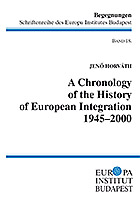 Begegnungen
Begegnungen
Schriftenreihe des Europa Institutes Budapest
Band 18.
Jenő Horváth
A Chronology of the History of European Integration
1945–2000
Edited and preface written by
Ferenc GLATZ
Budapest 2003
Europa Institut Budapest
Translated by Vera GÁTHY
Proof-read by Joseph HELD
This book was prepared in cooperation with and supported by
the Research Group on European History of the Hungarian Academy of Sciences
The publication was financially supported by
the Pro Renovanda Cultura Hungariae Foundation
ISBN 963 21063 5 0
ISSN 1416 3055
CONTENTS
|
Preface: On the Sense of the European Union (Ferenc Glatz)
|
7
|
|
I. THE FIRST STEPS (1945–1949)
1945 The End of the War in Europe
1946 Churchill’s Speech in Zurich
1947 The Marshall Plan
1948 The Treaty of Brussels
1949 The Beginnings of the Euro-Atlantic Integration
|
15
16
17
21
24
|
|
II. THE EUROPE OF THE SIX (1950–1972)
1950 The Schuman Plan of the Six
1951 The European Coal and Steel Community
1952 The Plan of the European Defence Community
1953 Plans about the European Political Community
1954 The Failure of the European Defence Community
1955 The Conference of Messina
1956 The Plans for the EEC and for EURATOM Emerge
1957 The Foundation of the EEC and the EURATOM
1958 The New Communities Start to Operate
1959 The First Reduction of Customs Duties
1960 The Realization of the EEC-Treaty in Speeded up
1961 The First British Application for Accession to the EEC
1962 The Fouchet Plan
1963 French Veto of the British Application for Accession
1964 Plan for the Fusion of the Three Communities
1965 The Policy of ’Empty Chairs’
1966 The Luxembourg Compromise
1967 Merger of the Institutions of the Three Communities
1968 The Realization of the Customs Union
1969 The Hague Summit
1970 The EC Finds Itself
1971 Agreement on British Accession
1972 Signing the Treaties on the Expansion of the EC
|
31
36
38
41
42
44
47
50
52
57
59
62
67
71
75
79
81
84
87
89
92
95
98
|
|
III. THE EUROPE OF THE NINE (1973–1980)
1973 The Accession of the United Kingdom, Denmark, and Ireland
1974 The United Kingdom Requested a Renegotiation of Its Accession
1975 The Lomé Convention
1976 The Tindemans Report
1977 Extension of the Competency of the European Parliament
1978 Widening External Relations of the EC
1979 The First Directly Elected European Parliament
1980 New Authorisations Given to the Commission
|
105
110
114
119
123
126
130
133
|
|
IV. THE EUROPE OF THE TEN (1981–1985)
1981 Greece Is the Tenth Member of the EC
1982 External Relations Brought to the Foreground
1983 The Birth of the ‘Blue Europe’
1984 The Spinelli Plan
1985 The EUREKA Program
|
139
143
146
150
154
|
|
V. THE EUROPE OF THE TWELVE (1986–1994)
1986 Portugal and Spain Are the New Members of the EC
1987 The Single European Government Enters into Force
1988 The Hanover Session of the European Council
1989 The Delors Plan on the Economic and Monetary Union
1990 German Reunification
1991 The EC in the Changing International Environment
1992 The Maastricht Treaty
1993 The Treaty of Maastricht Enters into Force
1994 The European Economic Area
|
161
166
169
175
181
189
201
212
219
|
|
VI. THE EUROPE OF THE FIFTEEN (1995–2000)
1995 Austria, Finland and Sweden Are the New Members of the European Union
1996 The Revision of the Treaty of Maastricht
1997 Signing of the Amsterdam Treaty
1998 Decision for Introducing the Euro
1999 The Crisis of the European Commission
2000 Nice – the Great Compromise
|
231
239
247
256
264
282
|
|
Index (Éva Kovács)
|
301
|
 Begegnungen
Begegnungen